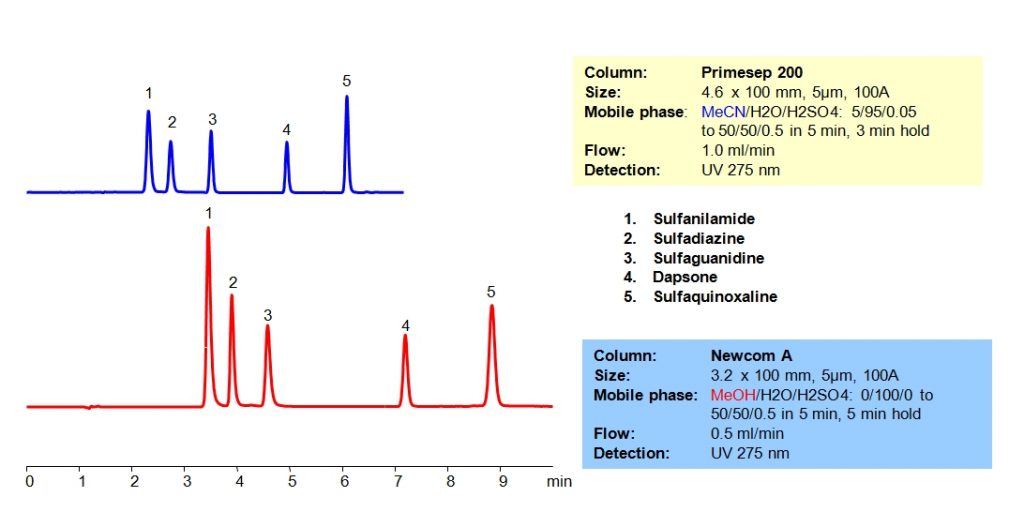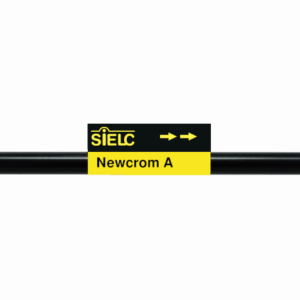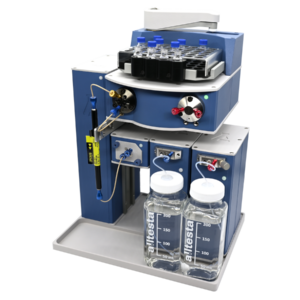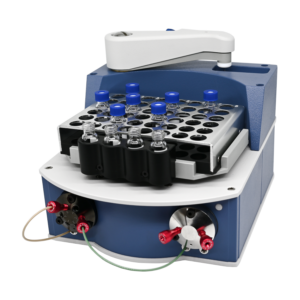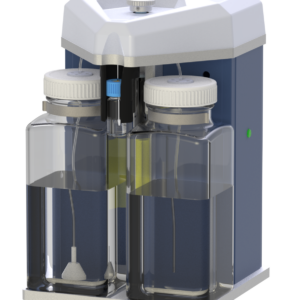HPLC Method for Sulfanilamide, Sulfadiazine, Dapsone, Sulfaguanidine, Sulphaquinoxaline on Newcrom A by SIELC Technologies
High Performance Liquid Chromatography (HPLC) Method for Analysis of Sulfanilamide, Sulfadiazine, Dapsone, Sulfaguanidine, Sulphaquinoxaline.
Antibiotics are widely used for treatment and prevention of bacterial infections.
Sulfanilamide is a sulfonamide antibacterial drug with the chemical formula C6H8N2O2S. It’s height of use was during World War II to treat and prevent the spread of infections among the Allies. Due to later discovery of more effective antibiotics, it is no longer as widely used. You can find detailed UV spectra of Sulfanilamide and information about its various lambda maxima by visiting the following link.
Sulfadiazine is a sulfonamide antibiotic with the chemical formula C10H10N4O2S. It is the treatment of choice for toxoplasmosis and is considered the second-line treatment against numerous other infections. It works by blocking the synthesis of folic acid in bacteria, which prevents cell reproduction. Sulfadiazine can be either taken orally or applied topically. You can find detailed UV spectra of Sulfadiazine and information about its various lambda maxima by visiting the following link.
Sulfaguanidine is a sulfonamide antibiotic with the chemical formula C7H10N4O2S. It is a guanidine derivative of sulfanilamide that works through inhibiting the synthesis of folic acid in bacteria. Most often, it is used to treat Bacillary dysentery.
Dapsone is a sulfone antibiotic with anti-inflammatory properties. As a gel, it is sold under the brand name Aczone as acne treatment, but it can also be used as part of treatment for other skin conditions including leprosy and dermatitis herpetiformis. It’s chemical formula is C12H12N2O2S.
Sulfaquinoxaline is a sulfonamide antibiotic that is typically used in veterinary medicine. It is used to treat Coccidiosis in cattle and sheep, as well as a variety infections in poultry. It is deemed not suitable for human use. It’s chemical formula is C14H12N4O2S.
Various antibiotics, particularly those with a sulfanilamide structure, were separated in HPLC using mixed-mode columns with varying strengths of ion-pairing groups. Methanol can be used in the mobile phase on Newcrom A column. The antibiotics were resolved on both columns with a gradient mobile phase consisting of acetonitrile (ACN) or methanol (MeOH), water and sulfuric acid (H2SO4) buffer. UV detection at 275nm.
| Column | Newcrom A, 3.2 x 100 mm, 5 µm, 100 A, dual ended |
| Mobile Phase | MeOH Gradient |
| Buffer | H2SO4 Gradient |
| Flow Rate | 0.5 ml/min |
| Detection | UV 275 nm |
| Class of Compounds | Drugs, Antibiotics |
| Analyzing Compounds | Sulfanilamide, Sulfadiazine, Dapsone, Sulfaguanidine, Sulphaquinoxaline |
Application Column
Newcrom A
Column Diameter: 3.2 mm
Column Length: 100 mm
Particle Size: 5 µm
Pore Size: 100 A
Column options: dual ended
Sulfadiazine
Sulfaguanidine
Sulfanilamide
Sulphaquinoxaline

